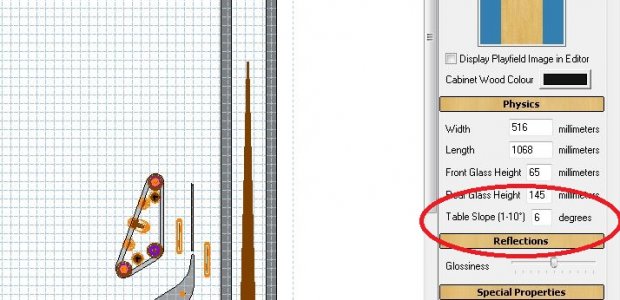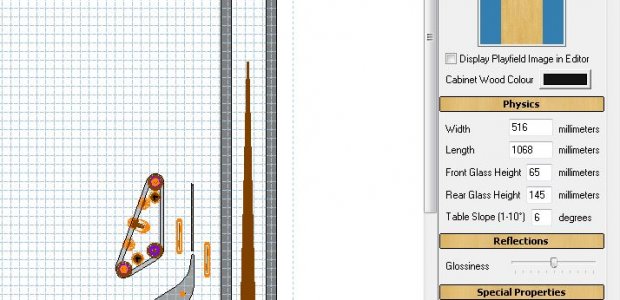- Joined
- Mar 16, 2013
- Messages
- 1,430
- Solutions
- 3
- Reaction score
- 681
- Points
- 131
- Favorite Pinball Machine
- Batman(Data East)
Hi....everyone!!!
I probably won't be the man for this task, but I can be the man to start this one.
Lately I am busy solving "what I call" sudden feeling of slowness in the gameplay of my tables, so to try to solve this problem, I have to play with the XML file,and improve physics.
Now .... and here comes my need to know more,so.... what is, the XML file? what's inside? what values to put to improve that particular context?
Inside this file there are things that I do not fully understand, some lines are incomprehensible to me, of what they are or can do.
It must also be said that many of these parameters or commands are configurable in the Bam menu, but as we all know, many things that found in Bam, it is difficult to understand what they can be, and in the doubt of touching something that can cause other problems, we do not touch them, or simply do not have a manual to better understand what we are looking at
Then we analyze each line of the file, and we try to give an explanation understandable for everyone, so I invite you to do some intervention if you wish, to help better understand what characterizes the XML file.
Then, this is the "XML" (standard FP) file generated in Bam, like this:
go to "Dev options" and then to "Physics tweaks" and press CTRL + SHIFT + C then, on the script CTRL + V .

 pinballnirvana.com
pinballnirvana.com
I probably won't be the man for this task, but I can be the man to start this one.
Lately I am busy solving "what I call" sudden feeling of slowness in the gameplay of my tables, so to try to solve this problem, I have to play with the XML file,and improve physics.
Now .... and here comes my need to know more,so.... what is, the XML file? what's inside? what values to put to improve that particular context?
Inside this file there are things that I do not fully understand, some lines are incomprehensible to me, of what they are or can do.
It must also be said that many of these parameters or commands are configurable in the Bam menu, but as we all know, many things that found in Bam, it is difficult to understand what they can be, and in the doubt of touching something that can cause other problems, we do not touch them, or simply do not have a manual to better understand what we are looking at
Then we analyze each line of the file, and we try to give an explanation understandable for everyone, so I invite you to do some intervention if you wish, to help better understand what characterizes the XML file.
Then, this is the "XML" (standard FP) file generated in Bam, like this:
go to "Dev options" and then to "Physics tweaks" and press CTRL + SHIFT + C then, on the script CTRL + V .
'=============================== PHYSICS XML ===========================
'<?xml version="1.0" encoding="utf-8"?>
'<document>
' <physics slope="6" fps="256" threaded="0"></physics>
' <ball newtonDamping="0" mass="18" gravity="4000" damping="0.25"></ball>
' <flipper rotationSpeedChart="{0.0,100.0}[0.0,100.0]" newtonDamping="1" releaseOmega="18" mass="20000" omega="33" moeMethod="0"
' leftXoff="0" leftYoff="0" leftZoff="0"
' rightXoff="0" rightYoff="0" rightZoff="0"></flipper>
' <bumper impulse="85.0" impulseRandomness="10" vectorRandomness="6"></bumper>
' <autoplunger mass="20000.0" force="60000.0"></autoplunger>
' <diverter mass="10000.0" omega="33.0"></diverter>
' <gate mass="2.0" gravity="4500.0" damping="0.25"></gate>
' <kicker impulse="800.0" vukImpulse="1300.0" impulseRandomness="4" vectorRandomness="1"></kicker>
' <plunger mass="20000.0" force="30000.0"></plunger>
' <slingshot impulse="480.0" impulseRandomness="15" vectorRandomness="10"></slingshot>
' <spindisk mass="10000.0" angularDamp="0.33" linearDamp="0.25"></spindisk>
' <spinner mass="45.0" gravity="100.0" angularDamp="0.5" angularAccel="5.0"
' spinDampLoose="0.325" spinBackLoose="2.850"
' spinDampNorm="0.575" spinBackNorm="3.250"
' spinDampTight="0.750" spinBackTight="3.500"></spinner>
' <emkicker mass="10000.0" omega="80.0"></emkicker>
' <varitarget mass="100.0" damping="0.5" tension="3.0" return="15.0"></varitarget>
' <magnet impulse="10.0" impulseRandomness="2"></magnet>
' <nudge impulse="100.0" impulseRandomness="25.0" warningLevel="160" leftAngle="65" upAngle="0.0" rightAngle="295"
' vectorRandomness="4" visualDistance="2" waitPeriod="300" maxBallVelocity="1000.0"></nudge>
' <defaultMat softnessCoef="0.02" elasticCoef="0.1" staticFriction="0.01" kineticFriction="0.02"></defaultMat>
' <playfieldMat softnessCoef="0.03" elasticCoef="0.2" staticFriction="0.01" kineticFriction="0.02"></playfieldMat>
' <metalMat softnessCoef="0.01" elasticCoef="0.05" staticFriction="0.01" kineticFriction="0.02"></metalMat>
' <woodMat softnessCoef="0.03" elasticCoef="0.2" staticFriction="0.01" kineticFriction="0.02"></woodMat>
' <plasticMat softnessCoef="0.02" elasticCoef="0.25" staticFriction="0.01" kineticFriction="0.02"></plasticMat>
' <rubberHardMat softnessCoef="0.04" elasticCoef="0.4" staticFriction="0.01" kineticFriction="0.02"></rubberHardMat>
' <rubberIntMat softnessCoef="0.05" elasticCoef="0.5" staticFriction="0.01" kineticFriction="0.02"></rubberIntMat>
' <rubberSoftMat softnessCoef="0.06" elasticCoef="0.6" staticFriction="0.01" kineticFriction="0.02"></rubberSoftMat>
' <gateMat softnessCoef="0.05" elasticCoef="0.66" staticFriction="0" kineticFriction="0"></gateMat>
' <kickerMat softnessCoef="0.01" elasticCoef="0.05" staticFriction="0.8" kineticFriction="0.8"></kickerMat>
' <rampMat softnessCoef="0.01" elasticCoef="0.05" staticFriction="0.01" kineticFriction="0.02"></rampMat>
' <plungerMat softnessCoef="0.04" elasticCoef="0.4" staticFriction="0.01" kineticFriction="0.02"></plungerMat>
' <spindiskMat softnessCoef="0.05" elasticCoef="0.5" staticFriction="2" kineticFriction="2"></spindiskMat>
'</document>
'=============================== PHYSICS XML ===========================

Resources by Paolo
Last edited:



